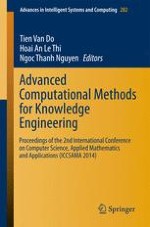The proceedings consists of 30 papers which have been selected and invited from the submissions to the 2nd International Conference on Computer Science, Applied Mathematics and Applications (ICCSAMA 2014) held on 8-9 May, 2014 in Budapest, Hungary. The conference is organized into 7 sessions: Advanced Optimization Methods and Their Applications, Queueing Models and Performance Evaluation, Software Development and Testing, Computational Methods for Mobile and Wireless Networks, Computational Methods for Knowledge Engineering, Logic Based Methods for Decision Making and Data Mining and Nonlinear Systems and Applications, respectively. All chapters in the book discuss theoretical and practical issues connected with computational methods and optimization methods for knowledge engineering. The editors hope that this volume can be useful for graduate and Ph.D. students and researchers in Computer Science and Applied Mathematics. It is the hope of the editors that readers of this volume can find many inspiring ideas and use them to their research. Many such challenges are suggested by particular approaches and models presented in individual chapters of this book.
